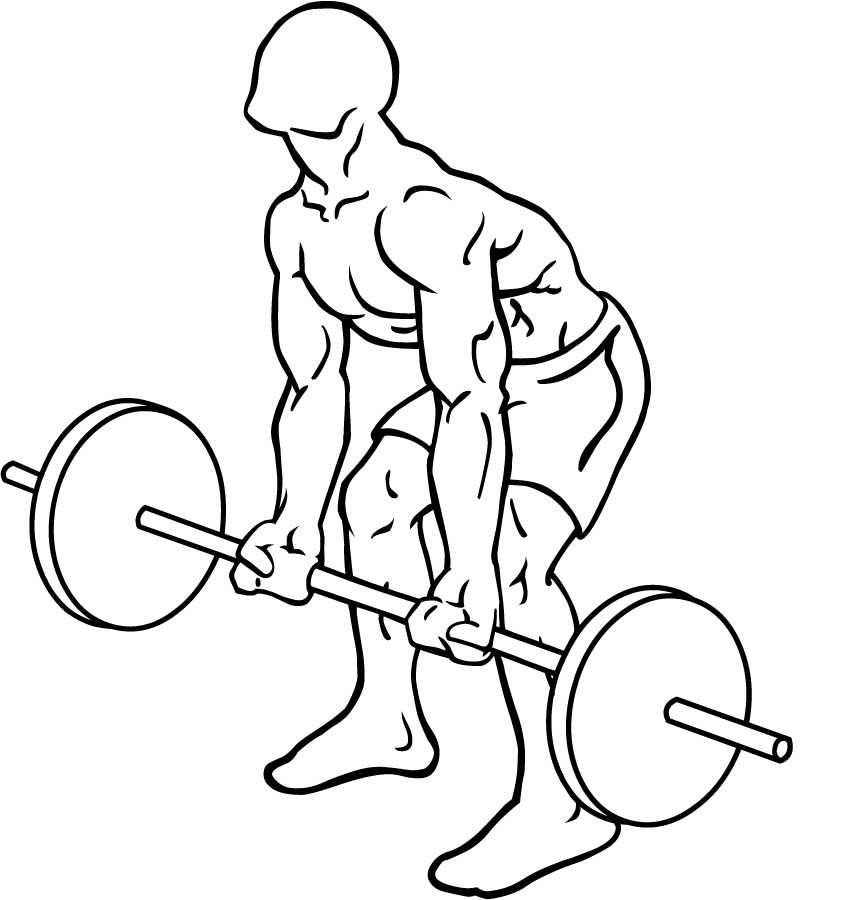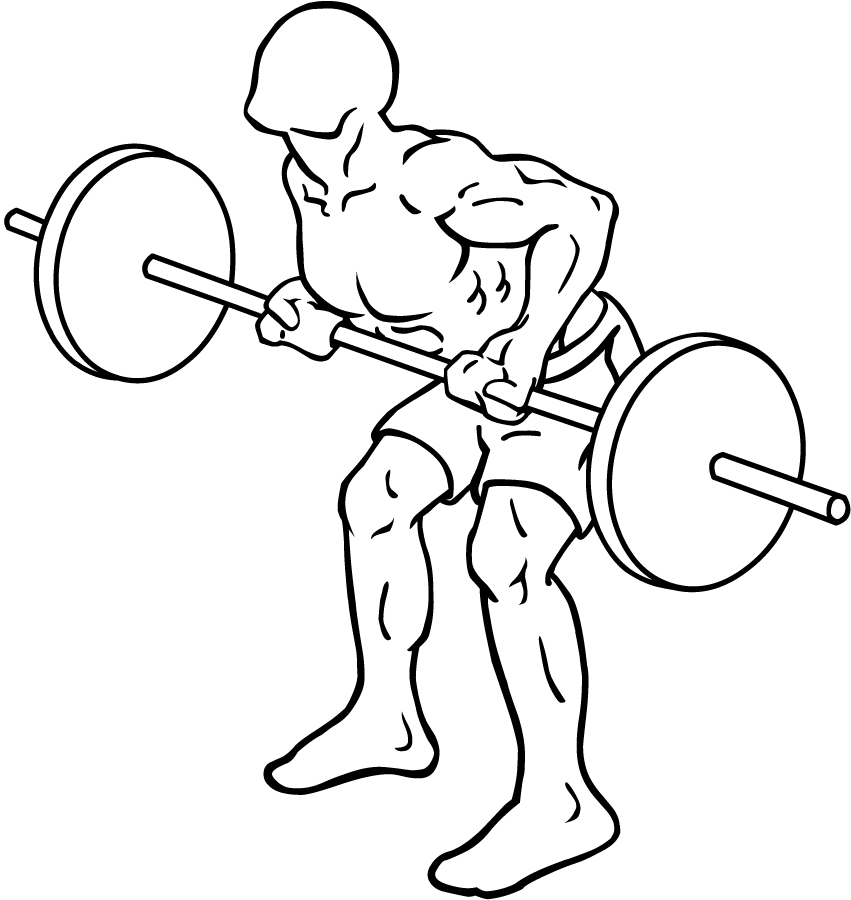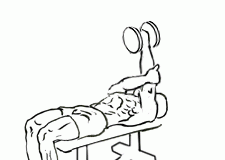Last Updated on September 26, 2014
The Reverse Grip Bent Over Barbell Row is a powerful exercise that primarily targets the middle back and biceps, helping to build a stronger and well-defined upper body. This exercise is a staple in many strength training and bodybuilding routines due to its ability to target the upper and mid-back muscles effectively while simultaneously engaging the biceps. When done correctly, it enhances strength, improves posture, and provides a balanced physique by strengthening both the back and arm muscles.
Why You Should Incorporate Reverse Grip Bent Over Barbell Rows
Incorporating Reverse Grip Bent Over Barbell Rows into your workout routine can yield numerous benefits:
- Balanced Upper Body Development: The exercise works the back and biceps, helping you develop a balanced physique.
- Enhanced Back Strength: By targeting the middle back muscles, it aids in overall back strength, which is crucial for various compound lifts like deadlifts and squats.
- Improved Grip Strength: Holding and lifting the barbell strengthens your grip, beneficial for other exercises and everyday tasks.
- Posture Improvement: Strengthening the upper back can counteract poor posture, especially for those who sit for long hours.
- Bicep Engagement: The reverse grip targets the biceps more directly, offering an alternative to traditional bicep exercises and helping you build stronger, defined arms.
Step-by-Step Guide to Reverse Grip Bent Over Barbell Rows
Let’s break down the process of performing the Reverse Grip Bent Over Barbell Row correctly:
Step 1: Setup and Positioning
- Choose the Appropriate Weight: Begin with a manageable weight to maintain form. Starting too heavy can compromise your posture and increase injury risk.
- Stand with Your Feet Hip-Width Apart: This stance provides stability and balance.
- Grip the Barbell with a Supinated (Underhand) Grip: This means your palms should be facing up, allowing you to target the biceps more directly while engaging the back muscles.
Step 2: Bending Over
- Slightly Bend Your Knees: This helps protect your lower back and allows for a more stable position.
- Lean Forward at a Slight Angle: Aim for a 45-degree angle to the floor. Keep your back straight and your chest up to avoid rounding the spine.
- Engage Your Core: Tightening your abdominal muscles will help stabilize your spine and keep your posture strong throughout the movement.
Step 3: The Pulling Motion
- Keep Your Elbows Close to Your Body: As you pull, focus on keeping your elbows tight against your sides.
- Lift the Barbell Toward Your Abs: Slowly pull the barbell upwards until it reaches your abdominal region. Avoid jerking or using momentum to lift the weight.
- Squeeze Your Shoulder Blades: At the top of the movement, squeeze your shoulder blades together to maximize back engagement.
Step 4: Pause and Lowering Phase
- Pause at the Top: Hold the contraction for a brief moment, feeling the engagement in your back and biceps.
- Return to the Starting Position: Slowly lower the barbell back to the starting position, ensuring that you maintain control over the weight.
- Repeat the Motion: Aim for 8-12 repetitions per set, depending on your fitness level and goals.
Muscles Worked in Reverse Grip Bent Over Barbell Rows
Understanding the muscles worked during this exercise can help you perform it more effectively and ensure you’re engaging the right areas:
- Latissimus Dorsi: The broadest back muscle, responsible for pulling movements and supporting spinal stability.
- Rhomboids: These muscles between the shoulder blades help pull the shoulder blades together.
- Trapezius: Located at the upper back, it assists in stabilizing the shoulder and neck.
- Biceps Brachii: The reverse grip activates the biceps to a significant extent, providing additional upper arm strength.
- Rear Deltoids: These shoulder muscles are engaged as stabilizers, assisting in keeping the shoulders pulled back.
Common Mistakes to Avoid
Performing the Reverse Grip Bent Over Barbell Row incorrectly can lead to reduced effectiveness and even injury. Here’s a list of common mistakes to avoid:
- Rounding the Back: Many lifters round their backs during the exercise, especially when lifting heavier weights. This posture can strain the lower back and lead to injury.
- Overextending the Wrists: Keeping your wrists neutral is essential. Bending the wrists too much can result in discomfort and strain.
- Using Momentum: Avoid swinging or jerking the barbell. Using controlled movements ensures that you’re working the targeted muscles effectively.
- Not Engaging the Core: A loose core leads to a weak foundation, which can make it challenging to maintain balance and proper form.
- Too Heavy Weights: Lifting more weight than you can handle often results in improper form. Start light, focus on your form, and increase the weight gradually.
Tips to Enhance Your Reverse Grip Bent Over Barbell Row
To get the most out of this exercise, consider the following tips:
- Focus on Mind-Muscle Connection: Visualize the muscles you’re targeting, and concentrate on engaging them during each repetition.
- Control the Eccentric Phase: The lowering part of the exercise (eccentric phase) is as crucial as the lift. Slow down during this phase to fully engage the muscles.
- Use a Mirror or Record Yourself: Observing your form can help you detect any mistakes in real-time and make adjustments.
- Breathe Properly: Inhale before pulling the weight up, then exhale as you lift. Breathing correctly helps maintain control and prevent dizziness.
- Stretch and Warm Up: A few dynamic stretches and warm-up exercises targeting the back, shoulders, and biceps can help prevent injuries.
Variations of the Reverse Grip Bent Over Barbell Row
Trying out variations of this exercise can target different areas or make it more challenging. Here are a few options:
- Dumbbell Reverse Grip Row: Use dumbbells instead of a barbell to increase the range of motion and activate stabilizing muscles.
- Seated Reverse Grip Cable Row: This variation uses a cable machine and can help reduce strain on the lower back, as you’re in a seated position.
- Smith Machine Reverse Grip Row: Using the Smith machine offers additional stability, allowing you to focus more on the target muscles.
- Yates Row: A slight variation where you stand with a slightly higher torso angle and use an underhand grip, targeting the lower lats and biceps more intensely.
Integrating Reverse Grip Bent Over Barbell Rows into Your Workout Routine
You can integrate Reverse Grip Bent Over Barbell Rows into various workout routines:
- Back Workout Day: Pair this exercise with other back-targeting exercises such as lat pulldowns, pull-ups, and seated rows.
- Upper Body Day: Combine it with exercises for the chest, shoulders, and arms to create a balanced upper body workout.
- Compound Movement Focus: Since the Reverse Grip Bent Over Barbell Row is a compound exercise, it can serve as a great addition to full-body workouts where you aim to hit multiple muscle groups.
Sample Workout Routine with Reverse Grip Bent Over Barbell Rows
Here’s a sample workout routine that includes Reverse Grip Bent Over Barbell Rows for building a well-rounded back and strong biceps:
- Warm-Up (5-10 minutes): Rowing machine or light cardio, followed by dynamic stretches for the back and shoulders.
- Reverse Grip Bent Over Barbell Rows: 3 sets of 8-12 reps
- Lat Pulldown or Pull-Ups: 3 sets of 10-12 reps
- Seated Cable Rows: 3 sets of 10-12 reps
- Dumbbell Bicep Curls: 3 sets of 10-15 reps
- Face Pulls (optional for rear deltoids): 3 sets of 12-15 reps
- Cool Down: Light stretching for the back and biceps
Benefits of Reverse Grip Bent Over Barbell Rows for Functional Strength
Building a strong back is essential not only for aesthetics but for functional strength as well. Here’s how Reverse Grip Bent Over Barbell Rows help you in daily activities:
- Lifting Heavy Objects: This exercise improves your ability to lift and carry heavy items with proper form.
- Posture Support: Strengthening the middle and upper back can alleviate tension in the shoulders and promote a healthier posture.
- Enhanced Pulling Power: Activities that involve pulling motions, such as rock climbing or rowing, benefit from the increased back and arm strength gained through this exercise.
How to Progress and Increase Intensity
- Add Weight Gradually: Increase the weight in small increments as your strength improves.
- Increase Repetitions or Sets: Adding a few more reps or sets can make the workout more challenging.
- Change the Grip: Switching to an overhand grip or alternating between grips can target different muscles and add variety to your routine.
- Tempo Variation: Slow down the movement, especially the lowering phase, to engage the muscles more thoroughly.
Safety Tips and Precautions
While the Reverse Grip Bent Over Barbell Row is highly effective, safety is paramount:
- Avoid Rounding the Back: Always keep your spine neutral to prevent lower back strain.
- Use a Weight Belt (Optional): If you’re lifting heavy, a weight belt can provide additional lower back support.
- Seek Guidance if New: If you’re unfamiliar with the form, seek advice from a fitness professional to ensure correct technique.
The Reverse Grip Bent Over Barbell Row is an excellent choice for anyone looking to build a stronger back and arms. By following the steps, tips, and variations outlined above, you can incorporate this exercise into your routine safely and effectively. Whether you’re a beginner or an advanced lifter, adding this exercise to your routine can yield significant strength and aesthetic gains, contributing to a more balanced and muscular physique.








